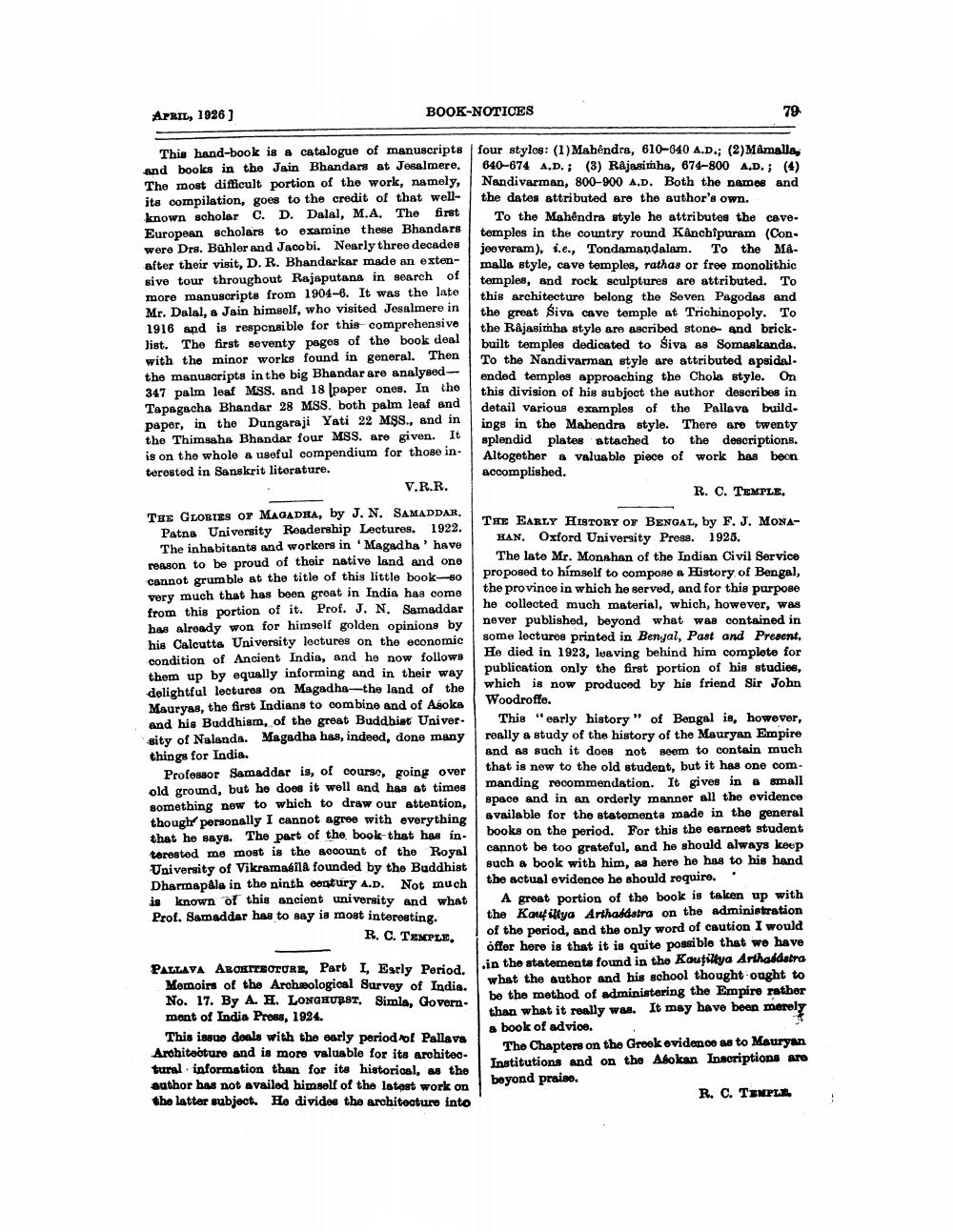________________
APRIL, 1926 )
BOOK-NOTICES
79
This hand-book is a catalogue of manuscripts and books in the Jain Bhandars at Jesalmere. The most difficult portion of the work, namely, its compilation, goes to the credit of that wellknown scholar C. D. Dalal, M.A. The first European scholars to examine these Bhandars were Drs. Bühler and Jacobi. Nearly three decades after their visit, D. R. Bhandarkar made an extensive tour throughout Rajaputana in search of more manuscripts from 1904-6. It was the late Mr. Dalal, a Jain himself, who visited Jesalmere in 1916 apd is responsible for this comprehensive Jist. The first seventy pages of the book deal with the minor works found in general. Then the manuscripts in the big Bhandar are analysed - 347 palm leaf MSS. and 18 paper ones. In the Tapagacha Bhandar 28 MSS. both palm leaf and paper, in the Dungaraji Yati 22 M$S., and in the Thimsaha Bhandar four MSS. are given. It is on the whole a useful compendium for those interested in Sanskrit literature.
four stylos: (1) Mahendra, 610-640 A.D.; (2) Måmalla, 640-674 A.D.; (3) Rajasimha, 674-800 A.D.; (4) Nandivarman, 800-900 A.D. Both the names and the dates attributed are the author's own.
To the Mahendra style he attributes the cavetemples in the country round Kanchipuram (Con. jee veram), i.e., Tondamandalam. To the M&malla style, cave temples, rathas or froe monolithic temples, and rock sculptures are attributed. To this architecture belong the Seven Pagodas and the great Siva cave temple at Trichinopoly. To the R&jasimha style are ascribed stone and brickbuilt temples dedicated to Siva se Somaskanda. To the Nandivarman style are attributed apsidal. ended temples approaching the Chola style. On this division of his subjoct the author describes in detail Various examples of the Pallava build. ings in the Mahendra style. There are twenty splendid plates attached to the descriptions. Altogether a valuable piece of work has been accomplished.
R. C. TEMPLE.
V.R.R.
THE GLORIES OF MAGADHA, by J. N. SAMADDAR.
Patna University Readership Lectures. 1922.
The inhabitants and workers in 'Magadha' have reason to be proud of their native land and one cannot grumble at the title of this little book-80 very much that has been great in India has come from this portion of it. Prof. J. N. Samaddar has already won for himself golden opinione by his Calcutta University lectures on the economic condition of Ancient India, and he now follows them up by equally informing and in their way delightful lectures on Magadha-the land of the Mauryas, the first Indians to combine and of Asoka and his Buddhism, of the great Buddhist University of Nalanda. Magadha has, indeed, done many things for India.
Professor Samaddar is, of course, going over old ground, but he does it well and has at times something new to which to draw our attention, though personally I cannot agree with everything that he says. The part of the book that has in. torestod me most is the socount of the Royal University of Vikramabila founded by the Buddhist Dharmapala in the ninth century A.D. Not much is known of this ancient university and what Prof. Samaddar has to say is most interesting.
R. C. TEMPLE.
THE EARLY HISTORY OF BENGAL, by F. J. MONA
HAN. Oxford University Press. 1925.
The late Mr. Monahan of the Indian Civil Service proposed to himself to compose a History of Bengal, the province in which he served, and for this purpose he collected much material, which, however, was never published, beyond what was contained in some lectures printed in Bengal, Past and Present, He died in 1923, leaving behind him complete for publication only the first portion of his studies, which is now produced by his friend Sir John Woodroffe.
This "early history" of Bengal is, however, really a study of the history of the Mauryan Empire and as such it does not seem to contain much that is new to the old student, but it has one commanding recommendation. It gives in a small space and in an orderly manner all the evidence available for the statements made in the general books on the period. For this the earnest student cannot be too grateful, and he should always keep such a book with him, as here he has to his hand the actual evidence he should require..
A great portion of the book is taken up with the Kouillya Arthaddatra on the administration of the period, and the only word of caution I would offer here is that it is quite possible that we have in the statements found in the Kautilya Arthaddatra what the author and his school thought ought to be the method of administering the Empire rather than what it really was. It may have been merely a book of advice.
The Chapters on the Greek evidence as to Mauryan Institutions and on the Abokan Inscriptions are beyond praise.
R. C. TEMPLI.
PALLAVA ABOEITBOTURE, Part I, Early Period.
Memoirs of the Archeological Survey of India. No. 17. By A. H. LONGHUBST, Simla, Govern. ment of India Press, 1924.
This issue deals with the early period of Pallava Architeoture and is more valuable for its architec. tural information than for its historical, as the author has not availed himself of the latest work on the latter subject. He divides the architecture into




